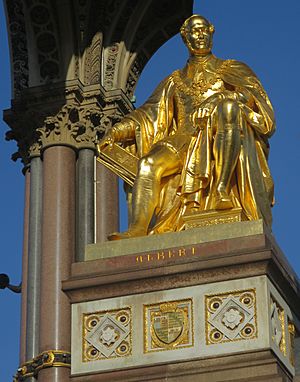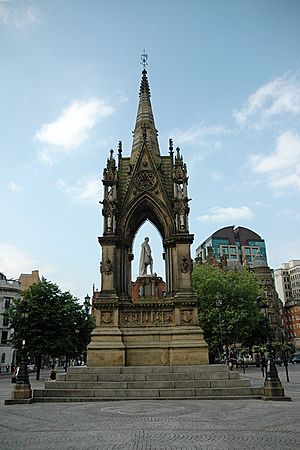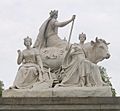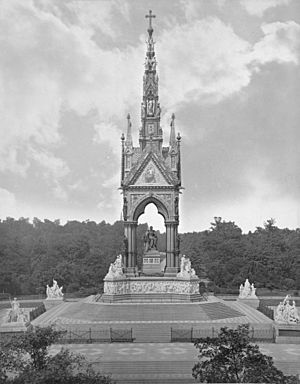Albert Memorial facts for kids

The Albert Memorial from the south side
|
|
| Coordinates | 51°30′09″N 0°10′40″W / 51.50250°N 0.17778°W |
|---|---|
| Location | London, W2 |
The Albert Memorial is a huge, fancy monument in Kensington Gardens, London. It stands just north of the Royal Albert Hall. Queen Victoria asked for it to be built to remember her husband, Prince Albert, who passed away in 1861.
Sir George Gilbert Scott designed the memorial in a style called Gothic Revival. It looks like a very detailed canopy or pavilion, about 54 metres (176 feet) tall. Underneath this canopy is a statue of Prince Albert. It took over ten years to build and cost a lot of money, about £120,000 back then, which is like £10,000,000 today! People donated money to pay for it.
Queen Victoria officially opened the memorial in July 1872. The statue of Albert was placed inside in 1876. Since 1970, it has been a Grade I listed building, meaning it's a very important historical site.
Contents
Why the Albert Memorial Was Built

Prince Albert died on December 14, 1861, when he was only 42 years old. People in the government and public life wanted to create a special way to remember him. Some ideas were to start a university or offer international scholarships.
However, Queen Victoria made it clear that she wanted a physical memorial. The Lord Mayor of London, William Cubitt, started a committee to raise money. This committee would also decide on a design that the Queen would approve.
The project was eventually managed by people close to the Queen. In April 1863, after much discussion, Sir George Gilbert Scott's design was officially chosen.
Other Albert Memorials
Prince Albert was very popular, so several "Albert Memorials" were built across the United Kingdom. The one in Kensington was not the first. The first one was built in Albert Square, Manchester, and was revealed in 1865.
Both the London and Manchester memorials show Prince Albert under a Gothic-style canopy. There's been some debate about whether one design influenced the other, or if both architects came up with similar ideas on their own.
Sir Gilbert Scott said his design was original. He wanted to create a special structure that looked like an ancient shrine, using precious materials and detailed decorations.
The Statue of Prince Albert
The job of creating the seated statue of Prince Albert for the memorial was first given to Baron Carlo Marochetti. He was a sculptor Queen Victoria liked a lot. But his first attempt was not approved by the architect, Sir George Gilbert Scott. Marochetti then died in 1867 before he could finish a better version.
In May 1868, John Henry Foley was asked to make the statue. He was also the sculptor for the memorial's "Asia" group. His design was approved by the Queen in December of that year. A full-sized model was placed on the monument in 1870.
The final statue was cast in bronze. Foley died in August 1874 before it was completely finished. The shiny bronze statue was officially placed in 1875, three years after the memorial opened. Prince Albert is shown looking south, towards the Royal Albert Hall. He is wearing the robes of a Knight of the Garter. He holds a catalogue from the Great Exhibition, a famous event that took place nearby in Hyde Park.
The Frieze of Parnassus
Around the central part of the memorial, there is a detailed sculpture called the Frieze of Parnassus. It is named after Mount Parnassus, a mountain in Greek mythology where the muses lived. This frieze shows 169 different famous people. These include composers, architects, poets, painters, and sculptors.
- Musicians and poets are on the south side.
- Painters are on the east side.
- Sculptors are on the west side.
- Architects are on the north side.
Henry Hugh Armstead carved the figures on the south and east sides, which included 80 painters, musicians, and poets. He grouped them by their home countries. John Birnie Philip carved the figures on the west and north sides, showing sculptors and architects in time order.
Allegorical Sculptures
At the corners of the memorial, there are two sets of sculptures that represent ideas or concepts.
- Four groups show Victorian industrial arts and sciences: Agriculture, commerce, engineering, and manufacturing.
- Four other groups represent the traditional four continents: Africa, the Americas, Asia, and Europe. Each continent group includes figures of people and a large animal. For example, there's a camel for Africa, a bison for the Americas, an elephant for Asia, and a bull for Europe.
These sculptures combine old symbols for the continents with new ideas from the Victorian era.
-
"Commerce" group
by Thomas Thornycroft -
"Engineering" group
by John Lawlor -
"Asia" group
by John Henry Foley
The Canopy
The design of the memorial's canopy was inspired by the Gothic Scaliger Tombs in Verona, Italy. The colorful mosaics on the outside and inside of the canopy were designed by Clayton and Bell. They were made by the Salviati company from Venice, Italy.
The canopy has several mosaics. Each of the four outside mosaics shows a main figure representing one of the four arts: poetry, painting, architecture, and sculpture. Each main figure is supported by two historical figures. For example, the poetry mosaic shows King David and Homer. The mosaics use many beautiful materials like enamel, polished stone, agate, onyx, jasper, cornelian, crystal, marble, and granite.
Around the canopy, there's a special message written in four parts. It says: Queen Victoria And Her People • To The Memory Of Albert Prince Consort • As A Tribute Of Their Gratitude • For A Life Devoted to the Public Good.
The pillars and special spaces (niches) of the canopy have eight statues. These statues represent practical arts and sciences like Astronomy, Geology, Chemistry, and Geometry.
Near the top of the canopy's tower, there are eight more statues. These represent moral and Christian virtues. They include Faith, Hope, Charity, Humility, Fortitude, Prudence, Justice, and Temperance. Above these statues are golden angels reaching towards the sky. At the very top of the tower is a gold cross.
-
The Scaliger Tombs in Verona, which inspired the memorial's design.
-
An exterior mosaic of Poesis (poetry) with Homer and King David.
The Sculptors
Many talented artists from the Royal Academy worked together on the Albert Memorial. Henry Hugh Armstead helped organize this huge effort.
Some of the sculptors and their works include:
- Thomas Thornycroft carved the "Commerce" group.
- Patrick MacDowell carved the "Europe" group.
- John Bell carved the "America" group.
- John Henry Foley carved the "Asia" group and started the statue of Albert.
- William Theed carved the "Africa" group.
- William Calder Marshall carved the "Agriculture" group.
- James Redfern carved the four Christian and four moral virtues.
- John Lawlor carved the "Engineering" group.
- Henry Weekes carved the "Manufactures" group.
The statue of Albert was started by Foley but finished by Thomas Brock. Armstead himself created about 80 figures on the south and east sides of the memorial. He also sculpted the bronze statues of Astronomy, Chemistry, Rhetoric, and Medicine.
Henry Weekes's "Manufactures" group shows a woman holding an hourglass, symbolizing how important time is in industry. An ironworker, a potter, and a weaver are also shown with their goods.
Later History and Restoration
In the late 1990s, the Albert Memorial was starting to look old and worn. A big restoration project was carried out by a company called Mowlem. They cleaned, repainted, and re-gilded the entire monument. They also fixed parts that were broken. During this work, the cross on top of the monument, which had been put on sideways during an earlier repair, was put back in the correct position.
The seated statue of Prince Albert, which is the main part of the memorial, is now covered in shiny gold leaf. For eighty years, the statue had been covered in black paint. People used to think it was painted black during World War I to hide it from German air raids or because of anti-German feelings. However, research before the restoration showed that the black coating was there before 1914. It was probably put on to protect the original gold leaf from air pollution.
You can take public tours of the memorial on the first Sunday of each month. These tours let visitors get a closer look at the detailed Frieze of Parnassus.
Images for kids
See also
 In Spanish: Albert Memorial para niños
In Spanish: Albert Memorial para niños


















